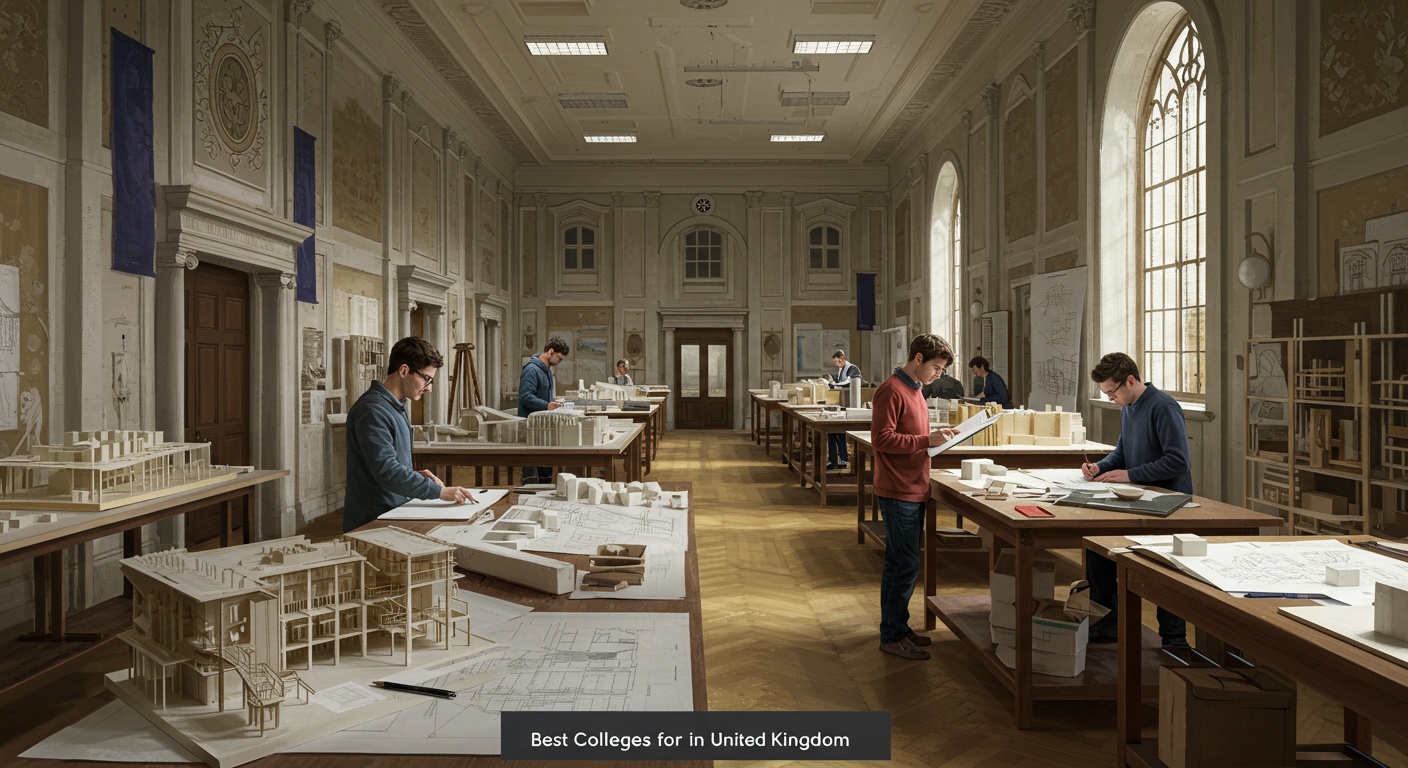The United Kingdom, a crucible of architectural innovation from gothic cathedrals to cutting-edge sustainable designs, offers fertile ground for aspiring architects. As parametric design and computational tools reshape the field, selecting the right academic foundation becomes paramount. This exploration begins by acknowledging the diverse pedagogical philosophies across UK institutions. From the studio-led, research-driven approach of the Bartlett School of Architecture, to the contextual and community-focused ethos of the University of Sheffield, each program cultivates distinct skill sets. We will delve into these varied approaches, highlighting programs that emphasize digital fabrication, sustainable practices. Urban design, ultimately guiding future architects toward the institutions best aligned with their individual aspirations and the evolving demands of the architectural profession.

Understanding Architectural Education in the UK
Choosing where to study Architecture is a significant decision. The UK offers a range of excellent institutions, each with its own strengths and specializations. Before diving into specific universities, it’s essential to grasp the structure of architectural education in the UK and what makes it unique. The standard path to becoming a registered Architect in the UK typically involves three stages:
- Part 1: An undergraduate degree in Architecture (usually a Bachelor of Arts or Bachelor of Science). This provides a broad foundation in architectural design, history, theory. Technology.
- Part 2: A postgraduate degree in Architecture (usually a Master of Architecture – MArch or Diploma in Architecture). This builds upon the undergraduate knowledge, fostering more advanced design skills and critical thinking.
- Part 3: Practical experience and professional examination. After completing Part 2, aspiring Architects must gain a minimum of 24 months of practical experience under the supervision of a registered Architect and pass a professional practice examination administered by the Architects Registration Board (ARB).
RIBA (Royal Institute of British Architects) accreditation is a crucial factor to consider. RIBA-validated courses meet high standards of architectural education and are recognized globally. Completing a RIBA-validated course is generally a prerequisite for becoming a registered Architect in the UK. It’s vital to check whether a course is RIBA-validated at Parts 1, 2. 3 levels.
Top Architecture Schools in the UK
Identifying the “best” school is subjective and depends on individual priorities, such as teaching style, research focus, location. Available resources. But, some universities consistently rank highly and are renowned for their Architecture programs. Here’s a look at some of the top contenders:
- University College London (UCL) – The Bartlett School of Architecture: The Bartlett is consistently ranked as one of the top Architecture schools globally. It’s known for its experimental and innovative approach to design, its world-leading research. Its diverse student body. The school emphasizes creative exploration and encourages students to push the boundaries of architectural thinking.
- University of Cambridge: Cambridge’s Architecture program blends theoretical rigor with practical application. It offers a strong foundation in design principles, history. Technology, while also encouraging students to develop their individual design philosophies. The program benefits from Cambridge’s interdisciplinary environment and its rich architectural heritage.
- University of Bath: Bath’s Architecture program is highly regarded for its focus on sustainable design and its strong links with industry. The university emphasizes a hands-on approach to learning, with opportunities for students to participate in live projects and work with leading architectural practices.
- University of Manchester: The Manchester School of Architecture (MSA) is a joint school between the University of Manchester and Manchester Metropolitan University. It offers a diverse range of programs, from undergraduate to postgraduate. Is known for its strong focus on social responsibility and urban design. MSA also benefits from its location in a vibrant and rapidly developing city.
- University of Sheffield: Sheffield’s School of Architecture is known for its supportive learning environment and its commitment to social justice. The program emphasizes collaborative learning and encourages students to engage with real-world challenges through community-based projects.
- Newcastle University: Newcastle’s Architecture program combines design studio work with theoretical studies and practical skills development. It emphasizes sustainable design and encourages students to explore innovative solutions to contemporary architectural challenges.
- University of Edinburgh: Edinburgh College of Art (ECA) at the University of Edinburgh offers a highly respected Architecture program that blends artistic creativity with technical expertise. The program benefits from its location in a city renowned for its architectural heritage and its vibrant arts scene.
These are just a few examples. Many other excellent Architecture schools exist in the UK. Researching each institution thoroughly and considering your own individual needs and preferences is crucial.
Factors to Consider When Choosing a School
Selecting the right Architecture school involves more than just looking at rankings. Several factors should influence your decision:
- Teaching Style: Do you prefer a highly structured program with a strong emphasis on technical skills, or a more experimental and design-led approach? Consider the teaching philosophy of each school and whether it aligns with your learning style.
- Course Structure: Does the program offer the specific modules and areas of specialization that interest you? Look at the course content in detail and consider whether it covers the topics you’re most passionate about.
- Studio Culture: Architecture schools often have distinct studio cultures. Some are highly competitive, while others foster a more collaborative and supportive environment. Research the studio culture of each school and consider which environment would best support your learning. Speaking to current students can provide valuable insights.
- Faculty Expertise: Research the faculty members and their areas of expertise. Are there professors whose work you admire or who specialize in areas that interest you? A strong faculty can significantly enhance your learning experience.
- Resources and Facilities: Consider the resources and facilities available at each school, such as design studios, workshops, computer labs. Libraries. Access to state-of-the-art equipment and resources can greatly enhance your learning.
- Location: The location of the school can also be a factor. Do you prefer to study in a large city or a smaller town? Consider the cost of living, the availability of cultural activities. The proximity to architectural landmarks and industry professionals.
- Industry Connections: Does the school have strong links with architectural practices and other industry professionals? Opportunities for internships, networking events. Guest lectures can provide valuable insights and connections.
- International Opportunities: If you’re interested in studying abroad, consider whether the school offers exchange programs or international study opportunities.
- Tuition Fees and Funding: Tuition fees can vary significantly between universities. Research the tuition fees for each program and explore available funding options, such as scholarships, grants. Student loans.
The Role of Technology in Architectural Education
Technology plays an increasingly essential role in Architecture. The best Architecture schools integrate technology into their curriculum. Key technologies used in Architecture include:
- Building details Modeling (BIM): BIM is a digital representation of physical and functional characteristics of a facility. It’s a collaborative process that allows architects, engineers. Contractors to create and manage building data throughout the project lifecycle.
- Computer-Aided Design (CAD): CAD software is used to create 2D and 3D drawings of buildings and structures.
- Rendering Software: Rendering software is used to create photorealistic images and animations of architectural designs.
- Parametric Design: Parametric design involves using algorithms and parameters to generate complex architectural forms. This allows architects to explore design options and optimize building performance.
- Virtual Reality (VR) and Augmented Reality (AR): VR and AR technologies are used to create immersive experiences of architectural designs, allowing clients and stakeholders to visualize and interact with buildings before they are built.
- 3D Printing: 3D printing is used to create physical models of architectural designs, allowing architects to test and refine their ideas.
Architecture programs often incorporate training in these technologies, preparing students for the demands of the modern architectural profession. Some schools may specialize in specific technologies or research areas, such as computational design or digital fabrication.
Comparing Course Structures: A Practical Example
To illustrate the differences between programs, let’s compare the course structures of two highly-rated schools: The Bartlett School of Architecture (UCL) and the University of Bath. This is a simplified comparison. It’s essential to consult the official university websites for the most up-to-date data.
| Feature | The Bartlett School of Architecture (UCL) | University of Bath |
|---|---|---|
| Undergraduate Program Focus (Part 1) | Emphasis on experimental design, theoretical exploration. Individual creativity. Studios are themed around different research areas. | Emphasis on sustainable design, practical skills. Industry collaboration. Strong focus on building technology and construction. |
| Postgraduate Program Focus (Part 2) | Advanced design research, specialized studios. Thesis projects. Offers diverse MArch programs with varying focuses. | Professional practice, design innovation. Advanced building technology. Focus on preparing students for professional registration. |
| Studio Culture | Highly diverse and experimental, with a strong emphasis on individual expression and pushing boundaries. | Collaborative and supportive, with a focus on teamwork and practical application of knowledge. |
| Industry Links | Extensive network of industry contacts, with opportunities for internships and collaborations. | Strong links with local and national architectural practices, with opportunities for live projects and work placements. |
| Technology Integration | Advanced digital design tools and fabrication facilities. Emphasis on computational design and digital experimentation. | Integrated building technology curriculum, with hands-on experience in sustainable design and construction techniques. |
This comparison highlights the distinct approaches of these two leading Architecture schools. The Bartlett emphasizes creative exploration and theoretical innovation, while Bath focuses on practical skills and sustainable design. Your choice will depend on your individual learning style and career aspirations.
Beyond the Curriculum: Extracurricular Activities and Networking
Your architectural education extends beyond the classroom. Actively participating in extracurricular activities and networking events can significantly enhance your learning and career prospects. Consider these opportunities:
- Student Societies: Join the Architecture society at your university. These societies often organize lectures, workshops, studio visits. Social events.
- Competitions: Participate in architectural design competitions. These competitions provide opportunities to test your skills, gain recognition. Build your portfolio.
- Workshops and Seminars: Attend workshops and seminars on topics related to Architecture. These events can provide valuable insights and skills that are not covered in the curriculum.
- Networking Events: Attend industry networking events and career fairs. These events provide opportunities to meet architects, designers. Other professionals.
- Internships and Placements: Seek out internships and work placements at architectural practices. These experiences provide valuable practical experience and can help you build your network.
- Travel and Study Abroad: Participate in study abroad programs or travel to visit architectural landmarks and experience different cultures.
Actively engaging in these activities will help you develop your skills, expand your network. Enhance your career prospects. Moreover, engaging with the wider architectural community through these means provides vital context and understanding of the profession beyond academic study.
Conclusion
The journey to becoming a successful architect in the UK begins with choosing the right educational foundation. We’ve explored institutions renowned for their innovative approaches, industry connections. Commitment to shaping future leaders in the field. Now, armed with this knowledge, it’s time to implement your strategy. Consider this your implementation guide: research faculty specialties that align with your architectural passions, attend virtual tours to get a feel for the campus culture. Most importantly, start building your portfolio now. Don’t wait until application deadlines loom. Experiment with different design styles, volunteer for community projects. Document your creative process meticulously. Your success will be measured not just by grades. By the strength of your portfolio, your ability to articulate your design vision. Your proactive engagement with the architectural community. Embrace the challenges, network relentlessly. Remember that every sketch, every model. Every conversation is a step closer to realizing your architectural dreams. Go build your future!
More Articles
Top Architecture Schools in Italy for Design Innovation
Best Business Management Programs in the United Kingdom
Top Law Schools in Canada for International Students
Leading Universities for Data Science in Germany
FAQs
So, I’m serious about architecture. Which UK colleges are, like, really good?
Alright, future architect! If you’re aiming high, you’ll want to look at the Bartlett School of Architecture (UCL) – consistently ranked top globally. The Architectural Association School of Architecture (AA) is also super prestigious and known for its avant-garde approach. Then there’s Cambridge, of course. The University of Manchester which has a stellar reputation and strong links to industry.
What’s the Architectural Association (AA) actually like? I’ve heard it’s a bit… Different.
You heard right! The AA is definitely unique. It’s independent, so not affiliated with a university in the traditional sense. It has a very experimental and theoretical focus, attracting students who want to push boundaries. Think less traditional lectures, more studio-based projects and radical thinking. It’s intense. Incredibly rewarding if that resonates with you.
Okay, aside from rankings, what should I actually consider when choosing a school?
Good question! Rankings are just one piece of the puzzle. Think about the course structure: is it studio-heavy, or more focused on history and theory? Consider the teaching style. Do you prefer lectures or more hands-on learning? Location matters too – do you want to be in a bustling city or a more relaxed campus environment? And importantly, look at the school’s ethos and specialisms. Some are known for sustainable design, others for urban planning. So on.
Do all these top schools require a portfolio? What are they looking for?
Yep, pretty much all architecture programs, especially the top ones, require a portfolio. They want to see your creative potential, not necessarily perfect architectural drawings (yet!). Include a range of work: sketching, photography, painting, sculpture, even graphic design – anything that shows your visual thinking and problem-solving skills. Show your process, your ideas. Your passion! Quality over quantity is key.
What about work experience? Will that help my application?
Absolutely! Any architecture-related work experience is a huge plus. Even shadowing an architect for a week, working on a construction site, or volunteering with a design organization can make your application stand out. It shows you’re serious about the field and have a realistic understanding of what it entails.
Is there any point in applying to these top schools if my grades aren’t perfect?
Don’t give up before you try! While grades are crucial, a strong portfolio and a compelling personal statement can definitely compensate for slightly lower grades. Highlight your strengths, show your passion. Explain why you’re a good fit for the program. Remember, they’re looking for potential, not just perfection.
What’s the job market like after graduating from a good architecture school in the UK?
The job market can be competitive. Graduating from a well-respected architecture school definitely gives you a leg up. Many graduates go on to work in architectural practices, while others explore related fields like urban design, landscape architecture, or even set design. Networking, internships. Building a strong portfolio during your studies are crucial for landing your dream job.



